Podcast
Questions and Answers
Which type of reproduction involves only one parent?
Which type of reproduction involves only one parent?
- Sexual reproduction
- Asexual reproduction (correct)
- Both sexual and asexual reproduction
- None of the above
Sexual reproduction results in offspring that are genetically identical to their parents.
Sexual reproduction results in offspring that are genetically identical to their parents.
False (B)
What are the stages in the life cycle of a frog?
What are the stages in the life cycle of a frog?
Tadpole, metamorphosis, adult frog
Friction is a force that opposes ______ between surfaces in contact.
Friction is a force that opposes ______ between surfaces in contact.
Which of the following methods can help reduce friction?
Which of the following methods can help reduce friction?
Kinetic friction acts on a stationary object.
Kinetic friction acts on a stationary object.
What is the difference between static and kinetic friction?
What is the difference between static and kinetic friction?
Match the type of friction with its example:
Match the type of friction with its example:
Flashcards
Asexual Reproduction
Asexual Reproduction
Reproduction that involves only one parent, resulting in offspring genetically identical to the parent.
Sexual Reproduction
Sexual Reproduction
Reproduction involving two parents, resulting in genetically varied offspring.
Internal Fertilization
Internal Fertilization
Fertilization that occurs inside the female's body.
External Fertilization
External Fertilization
Signup and view all the flashcards
Metamorphosis (Frog)
Metamorphosis (Frog)
Signup and view all the flashcards
Tadpole
Tadpole
Signup and view all the flashcards
Friction
Friction
Signup and view all the flashcards
Static Friction
Static Friction
Signup and view all the flashcards
Kinetic Friction
Kinetic Friction
Signup and view all the flashcards
Sliding Friction
Sliding Friction
Signup and view all the flashcards
Rolling Friction
Rolling Friction
Signup and view all the flashcards
Reproduction
Reproduction
Signup and view all the flashcards
Study Notes
Reproduction in Animals
- Reproduction is the biological process by which new individual organisms – "offspring" – are produced from their "parents".
- Two main types of reproduction are:
- Asexual reproduction: involves only one parent and results in offspring that are genetically identical to the parent. Common methods include binary fission, budding, fragmentation, and vegetative propagation.
- Sexual reproduction: involves two parents and results in offspring that exhibit genetic variation from their parents. The process commonly involves the fusion of male and female gametes (sex cells).
- Examples of asexual reproduction in animals include budding in hydra and fragmentation in starfish.
- Examples of sexual reproduction in animals include internal fertilization (e.g., mammals, birds) and external fertilization (e.g., fish, amphibians).
- Internal fertilization occurs inside the body of the female, whereas external fertilization takes place outside the body of the female.
Stages in the life cycle of a frog
- Frogs undergo metamorphosis, transforming from tadpoles to adult frogs.
- Tadpoles are born in water and have gills.
- They undergo a series of changes such as the development of lungs and legs.
- Finally adult frogs live on land and have lungs to breathe.
Friction
- Friction is a force that opposes motion between surfaces in contact.
- It arises due to the irregularities at the microscopic level of contacting surfaces.
- Friction can be either static or kinetic.
- Static friction prevents an object from moving when a force is applied. Its value is adjusted to match the applied force up to a maximum before the object begins to slide.
- Kinetic friction acts on a moving object and opposes the direction of motion.
- Factors affecting friction include:
- Nature of the surfaces (rough surfaces have higher friction than smooth surfaces).
- Force pressing the surfaces together (greater force results in higher friction).
- Friction can be helpful (e.g., walking, writing, braking in vehicles); however, it can also be a source of energy loss (e.g., wear and tear on machines).
- Methods to reduce friction include using lubricants (e.g., oil, grease), ball bearings, and streamlining.
Types of Friction
- Sliding friction: Occurs when two surfaces slide past each other. Examples include sliding a box across the floor or dragging a chair across a carpet.
- Rolling friction: Occurs when an object rolls across a surface. Examples include a wheel rolling on the ground or a ball rolling down a hill. Rolling friction is generally less than sliding friction.
- Fluid friction: Occurs when an object moves through a fluid (liquid or gas). Examples include swimming, flying, or sailing. Fluid friction depends on the shape and speed of the object.
Reducing Friction
- Using lubricants: Applying substances like oil or grease to reduce friction between surfaces.
- Using ball bearings: Replacing sliding surfaces with ball bearings reduces the amount of friction.
- Streamlining: Shaping objects to reduce air or water resistance and consequently reduce friction.
- Using wheels or rollers: Rolling objects use less force than sliding and therefore experience less friction.
Studying That Suits You
Use AI to generate personalized quizzes and flashcards to suit your learning preferences.




